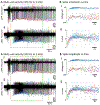Multiscale recordings reveal the dynamic spatial structure of human seizures
- PMID: 30898669
- PMCID: PMC6588430
- DOI: 10.1016/j.nbd.2019.03.015
Multiscale recordings reveal the dynamic spatial structure of human seizures
Abstract
The cellular activity underlying human focal seizures, and its relationship to key signatures in the EEG recordings used for therapeutic purposes, has not been well characterized despite many years of investigation both in laboratory and clinical settings. The increasing use of microelectrodes in epilepsy surgery patients has made it possible to apply principles derived from laboratory research to the problem of mapping the spatiotemporal structure of human focal seizures, and characterizing the corresponding EEG signatures. In this review, we describe results from human microelectrode studies, discuss some data interpretation pitfalls, and explain the current understanding of the key mechanisms of ictogenesis and seizure spread.
Keywords: Epilepsy; Focal seizures; Human single unit activity; Seizure localization; Surround inhibition.
Copyright © 2019 Elsevier Inc. All rights reserved.
Conflict of interest statement
Competing Interests: The authors have no competing interests to declare.
Figures



References
-
- Ahmed OJ, Kramer MA, Truccolo W, Naftulin JS, 2014. Inhibitory single neuron control of seizures and epileptic traveling waves in humans. BMC ….
-
- Alarcon G, Garcia Seoane J, Binnie C, Martin Miguel M, Juler J, Polkey C, Elwes R, Ortiz Blasco J, 1997. Origin and propagation of interictal discharges in the acute electrocorticogram. Implications for pathophysiology and surgical treatment of temporal lobe epilepsy. Brain 120, 2259–2282. - PubMed
-
- Babb TL, Crandall PH, 1976. Epileptogenesis of human limbic neurons in psychomotor epileptics. Electroencephalogr. Clin. Neurophysiol 40, 225–243. - PubMed

